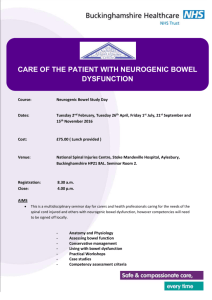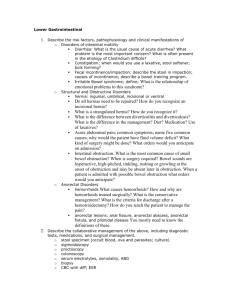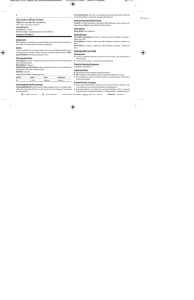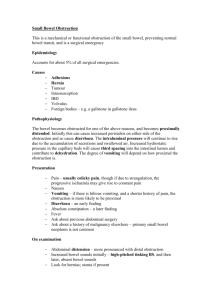intestine disorders
advertisement
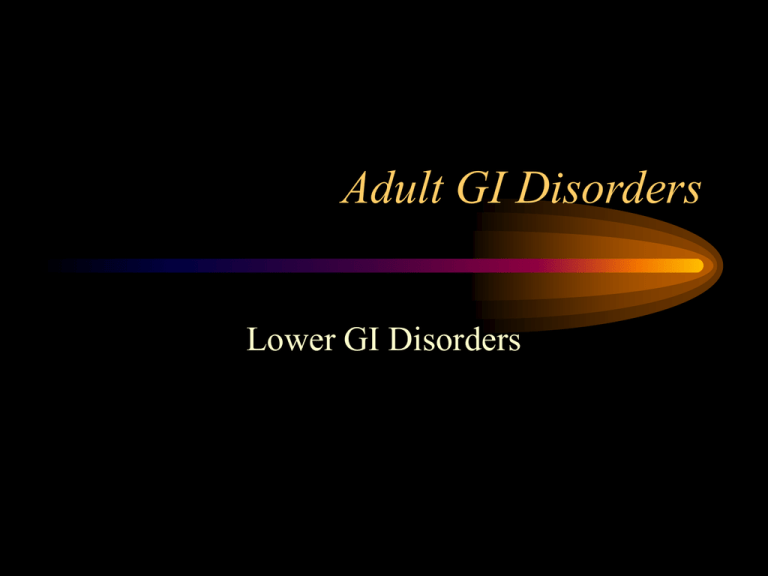
Adult GI Disorders Lower GI Disorders Appendicitis inflammation of vermiforn appendix d/t infection • Assessment – Progressive, severe, RLQ or periumbilical area pain – Pain localized in RLQ(McBurney’s point) • worse with movement, coughing, sneezing – – – – – anorexia, constipation nausea, vomiting rebound tenderness slight temperature moderate leukocytosis Nursing Plan of Care – Assist with diagnostics, ie UA, IVP, Rectal – NPO, narcotics after cause of pain determined, maintain bedrest – Pre op: keep in high fowlers – NO CATHARTICS or ENEMAS – Monitor vital signs Goals •Recognize and treat symptoms •Prevent death from complications •Re-establish normal bowel function Nursing Care: Post Op • • • • • • Maintain fowlers Care of nasogastric tube, suction prn Check for return of peristalsis May need enema, 3rd-4th day post-op Health education (review signs/symptoms) Discharge instruction – monitor incision, watch for infection, return of bowel function, return of symptoms Hemorrhoids • Pathophysiology – congestion of the veins of the hemorrhoidal plexus – leads to varicosities of rectum and anus d.t. elevated intra-abd pressure from constipation, straining when defecating, pregnancy – Heredity,obesity,long standing/sitting occupations – also with cirrhosis and portal hypertension • Assessment Data – Internal: painless, bleeding with defecation – External: apparent outside anal sphincter • inflammation & pain if ruptures w/subsequent thrombosis • itching • Goal – alleviate symptoms – Provide pre/post-op care for hemorrrhoidectomy – Health education to prevent occurence Interventions • Medical – analgesic ointment:Nupercaine – ice or warm compresses – sitz baths – stool softeners – local sclerosing may be done, R.N. assists with procedure • Surgical: post op – watch hemorrhage (1st 24 hr and 7-10 days post-op) – promote comfort: ice or warm compresses – watch infection – bulk laxatives(promote B.M) – education: sitz bath, bulk in diet(to prevent constipation) encourage fluid, daily BM, stool softeners, laxatives Evaluation •Verbalizes plan for bowel elimination •Verbalizes signs and symptoms of recurrence •Verbalizes signs and symptoms of complications, i.e. bleeding, pain, constipation, etc. •Recovers without complications from the surgery Diverticulosis, Diverticulitis • Outpouching of mucosa through a weak point in muscle layer of bowel wall that: • gets impacted with feces(Diverticulosis) or • gets inflammed(Diverticulitis) • Causes are unknown • Goal: relieve pain & restore normal bowel function Nursing Plan of Care • Administer medications – Narcotics (Demerol) antispasmodics bulk laxatives(Metamucil) antibiotics , • Assess bowel sounds, report changes(increase or decrease) • Observe type, color, frequency of stool • Intake and output(record) • Observe for complications – peritonitis, obstruction, hemorrhage • Dietary education – high fiber, bran, lots of fluid(8 glasses per day), bulk Evaluation • • • • Patient establishes regular bowel habits without pain Patient follows diet principles Verbalizes understanding of medications Patient verbalizes signs/symptoms of complications Ulcerative colitis • Inflammatory and ulcerative disease of colon • Superficial ulcers seen in mucosa that – bleed – become edematous – become abscessed causing reduced absorbive surface of the bowel • Cause unknown(auto-immune) • May be seen more with certain personalities – Independent exterior but dependent interior – Structured persons who tend to be perfectionistic Ulcerative colitis • Assessment(Physical) – frequent diarrhea – stool with mucus, blood, pus – colicky abdominal cramps, distention – low grade fever – fluid and electrolyte imbalance – wt loss, anorexia – weakness cachexia • Psychosocial/Cultural Occurs most often in • – Adolescents Young adults Jewish descent causes depression, anger, frustration – stress may cause exacerbation Goals •Restore nutrition/ F&E balance •Combat infection •Promote comfort •Decrease bowel motility •Assist patient to cope with •Alteration in body image •Psychological problems Nursing Plan of Care • • • • • • • Antibiotics to prevent or treat secondary infections ACTH or adrenal steroids(decrease inflammation) Bedrest, as needed Sitz bath, prn Lomotil to decrease GI motility Emotional support Protect perineum, buttock and anal area – Wash – Lubricants to prevent skin breakdown – Ointments to relieve discomfort Nursing Care continued... • Weight, q.d. • Assess nutritional status (anemia, vitamin K deficiency, dehydration) • High protein, high calorie diet, TPN • Record type, amount, character of stools • Education if surgery indicated Ileostomy • Pre op – prepare for bowel surgery – no enemas – watch fluid and electrolyte status • Post Op – care of skin and stoma – observe for peritonitis – maintain high protein, high calorie, high vitamins – Teaching rehabilitation principles – Referrals(to community health nurse) – discharge planning(social worker for financial, etc.) Evaluation •Patient has less diarrhea and is able to control or manage other signs and symptoms •Patient maintains their nutritional status •Patient verbalizes knowledge of the disease •Patient follows up on their outpatient appointments Regional enteritis (Crohn’s Disease) • Chronic inflammatory disease of small intestine affecting the terminal ileum. • Results in chronic diarrhea • Causes are unknown Crohn’s • Physical – – – – – – crampy pain after meals chronic diarrhea, melena low grade fever abd tenderness lymphadenitis UGI> string sign present, suggests a constriction of a segment of intestine • Psychosocial – more common in Jews of European ancestry – familial tendency – Age, 15 - 35 years • Goals – promote comfort – adequate hydration and nutrition Nursing Plan of Care • Diet low in residue, roughage and fat, high in calories, protein, vitamins • Rest periods • Antimicrobials to control inflammation • Assess F & E status • May need colon resection • Evaluation – maintains F & E status free of symptoms understands diet , Intestinal Obstruction • Blockage of intestinal tract that inhibits passage of fluid, gas, feces • Caused by – mechanical obstruction (strangulated hernia, adhesion, cancer, volvulus, intussusception) – neurogenic obstruction (paralytic ileus, uremia, electrolyte imbalance(low K), spinal cord lesion) – Vascular disease (occlusion of superior mesentery vessels) Intestinal Obstruction • Physical – loud frequent bowel sounds above obstruction – intermittent & cramping pain – vomiting (fecal) – distention, no stool or gas passage – severe F & E imbalance – shock • Goal – relieve discomfort – return of normal bowel peristalsis and function Nursing Plan of Care • Administer intravenous fluid, electrolytes • Administer pain medication (avoid morphine: d/t effect on respiratory system) • Maintain intestinal decompression using a Miller Abbott tube, (see nursing care in textbook) • Skin/mouth care • Watch respiration's, abd. distension may cause resp. distress, V.S. • Check abdomen q2h for changes(distension, rigidity, or pain) Nursing Care cont.…. • Assess for return of peristalsis – listen for bowel sounds, check abdominal girth, passage of stool • If no resolution, may need surgery • Maintain diet according to disease that caused problem • Teach good bowel habits – avoid harsh laxatives drink fluid stool softeners regular exercise , Evaluation •Patient remains free of pain •Patient experiences normal bowel elimination •Patient normalizes their fluid and electrolyte balance •Patient verbalizes correctly diet changes

